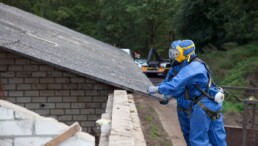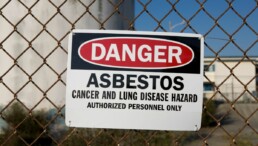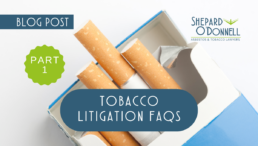Were You Exposed to Asbestos at Berlin Mills or the Cascade Mill in New Hampshire?
Pulp and paper mills have long been one of the most hazardous workplaces for asbestos exposure, and those in Berlin and Gorham, New Hampshire are no exception. These mills, originally owned by the Berlin Mills Company, later renamed Brown Paper Company (Brown Company), played a pivotal role in the social and economic development of both towns. At their peak, the mills employed thousands of workers, transforming Berlin and Gorham into thriving New England mill towns. By 1917, the Brown Company operated three paper mills and owned 4,250,000 acres of timberland, making it the largest pulp and paper manufacturer in the world, and earning Berlin the nickname “the city that trees built”. Key facilities included the mills in Berlin and the Cascade Mill, a few miles down the road in Gorham, which specialized in finishing papers.
In communities like Berlin and Gorham, the mills became the economic lifeblood of the towns and most of the residents worked, either directly or indirectly, for the Brown Company. The Berlin Sun writes that “at one time Brown Company had six manufacturing divisions: 1) a pulp division producing sulphite and kraft pulps for everything from cellophane and photographic papers to tissue and specialty papers; 2) a paper division producing Nibroc towels, industrial wipes and tissue; 3) Bermico Division which created a bituminized fibre pipe for sewers and underground electric systems; 4) Onco Division which produced a sheeting for shoe insoles, wallets, and handbags; 5) Chemical and Solka-Floc Division which created chemicals like liquid chlorine and caustic soda as well as Solka-Floc, a refined wood cellulose used in cigarette filters and rubber soles, and 6) a lumber division.”
The widespread industrial use of asbestos at the time left these workers exposed to serious health risks, including mesothelioma, a form of cancer that affects the protective lining of the lungs, abdomen, heart, and other major organs in the body. The disease takes decades to develop—typically 20-50 years from initial exposure—and its only known cause is asbestos exposure. Since the mills weren’t shut down for good until 2006, they continue to have lasting health impacts on former mill workers and their families to this day.
Asbestos Exposure in Berlin Mills
Based on our decades of work on behalf of mesothelioma victims and their families, we know that one of the most dangerous sources of workplace asbestos exposure in the country is in pulp and paper mills. Asbestos was ideal for industrial applications because of its resistance to heat, fire, and chemicals, and was widely used in parts and equipment throughout the mills. However, when these asbestos-containing materials had to be repaired, or even during routine upkeep and maintenance, microscopic asbestos fibers could be disturbed and sent into the surrounding environment. Workers in the vicinity unknowingly inhaled these fibers, setting the stage for serious health consequences, including an increased risk of developing mesothelioma later in life.
Mill workers regularly exposed to asbestos during their work in pulp and paper mills owned by the Brown Company include:
- Boilermakers
- Electricians
- Maintenance workers
- Pipefitters
- Machine tenders
- Mechanics
- Carpenters
- Millwrights
- Welders
- Fabricators
- General laborers
- Outside contractors
Every day tasks in the mills routinely brought workers into contact with asbestos-containing parts and equipment. Pumps, valves, gaskets, packing, insulation, and thousands of feet of pipes were all common sources of exposure. Dryer felts, essential to the paper-making process, also contained asbestos. Even the buildings themselves, built with asbestos-laced materials in their walls, ceilings, and roofs, posed a risk during maintenance, renovation, or demolition.
Scheduled shutdowns for cleaning, repair, or maintenance, along with unexpected breakdowns, only intensified the danger. When equipment was offline, every minute counted. Workers and outside contractors alike were called upon to get the mill back online as quickly as possible, exposing many to airborne asbestos fibers without protective equipment, or even knowledge of the risks.
Secondary Asbestos Exposure
The effects of asbestos exposure in Berlin and Gorham were far-reaching, and it wasn’t just mill workers who were exposed. It stands to reason that workers who came into contact with asbestos fibers at work would carry these fibers back home, in their cars and on their clothing. Our clients include the spouses of former Berlin Mills and Cascade Mill workers, as well as their sons and daughters, who are only now beginning to show symptoms of mesothelioma. Wives who regularly laundered contaminated clothing and children who hugged their father when he got home from work, unwittingly breathed asbestos fibers into their lungs.
Contact an Experienced Mesothelioma Attorney
If you believe you or a loved one has developed mesothelioma as a result of their job history, we encourage you to reach out to an experienced mesothelioma lawyer to see if you may be entitled to financial compensation. Shepard O’Donnell’s extensive experience with mesothelioma cases originating in paper mills across Massachusetts and New Hampshire, including the mills in Berlin-Gorham, has resulted in life-changing verdicts or settlements for those suffering from this terrible disease and their families. Our significant collection of evidence regarding asbestos exposure in mills operated by Mead Westvaco, Hollingsworth & Vose, Kimberly Clarke, and Brown Company, includes proprietary information not used by other firms. Contact us for a free, no obligation consultation.
Were You Exposed to Asbestos at the Willow Mill in South Lee, MA?
One of the most common ways people are exposed to asbestos is in the workplace. Pipefitters, boilermakers, construction workers, auto mechanics, even veterans were regularly exposed to asbestos on the job, inhaling the microscopic fibers disturbed during the course of their work and increasing their risk of developing mesothelioma later in life. Based on our decades of work on behalf of mesothelioma victims and their families, we know that one of the deadliest sources of workplace asbestos exposure was in paper mills.
From the wet end to the dry end of the paper making process, the Willow Mill in South Lee, Massachusetts used asbestos extensively in its paper-making for several decades. Originating as the Hurlbut Mill on the banks of the Housatonic River in South Lee in the mid-1800s, the mill was acquired by Mead Corporation in the 1950s and soon after began making specialty papers. After merging with the Westvaco Corporation in the early 2000s, MeadWestvaco continued operating the mill until it was sold to Onyx Paper, which operates it to this day.
Among other types of paper, the Willow Mill produced the 650-series specialty friction paper based on a design patent co-owned by Mead and BorgWarner, an automotive supplier, to be used in automatic transmissions in cars and trucks. This paper contained asbestos, which is both durable and heat resistant, making it ideal for use in transmissions and clutch plates where significant heat is generated due to friction and was produced in South Lee until 1983. Evidence shows that the Mead Corporation recognized a problem with the way it was handling asbestos fibers at the Willow Mill.
The Deadly Life Cycle of Asbestos Friction Paper
The 650-series friction paper produced at the Willow Mill used two of the most dangerous forms of asbestos in the world: 1) crocidolite, also known as African Blue, the most carcinogenic type of asbestos, and 2) chrysotile, a less potent but still extremely dangerous fiber. Our extensive volume of evidence regarding asbestos use at the Willow Mill shows that, from the moment the asbestos shipment was picked up to the moment the final rolls of paper left the mill for the BorgWarner facility in Illinois, there were significant risks of exposure to deadly airborne asbestos fibers to workers and bystanders.
Before the asbestos even entered the facility, a driver was sent from the mill to Boston to meet the container ships arriving from South Africa to pick up a container of bags of raw asbestos for transport to Willow Mill. Once back at the mill in South Lee, the driver would unload the bags of African Blue, and employees would dump the 50lb bags of asbestos by hand into the hydropulper, releasing trillions of tiny airborne fibers. We know from internal documents that the company did not require workers to wear protective clothing or masks. Broken and open bags were often left in storage, further contaminating the air at the mill. Interestingly, we know of one driver who kept a chart showing pictures of venomous African snakes next to the loading platform. Oftentimes, the container from South Africa would have one or more stowaways hidden inside—colorful snakes that could slither out at any moment! Little did he know that the snakes were a far less deadly threat than the crocidolite itself.
The slurry created by the hydropulper was then spread onto screens to make the paper, was then pressed and dried, and rolled onto giant rolls by a rewinder. Each step of the process presented a hazard. Not only did the paper drying process itself produce asbestos dust, dryer felts often contained asbestos and the process of cutting or changing the felts also released respirable asbestos fibers. Rewinder operators were exposed to asbestos fibers as the dried paper was rolled. Cutter operators, whose job it was to smooth out the jagged edges of the rolled paper, were also exposed when asbestos-containing dust was created during the cutting process. The leftover scraps, or “broke”, were collected in the broke room, resulting in heavy exposure for those emptying and baling the scraps and shavings.
Mill workers regularly exposed during runs of asbestos grade paper include:
- rewinder operators and helpers
- brokemen
- slusher operators and helpers
- beater engineers, operators, and beaterman helpers and hands
- machine tenders, backtenders, hands and trainees
- cutter machine operators and helpers
- sorters
- trimmer operators
- technicians
- burning oven operators
- tour operators
- utility men
Dust hygiene reports from the Willow Mill reveal that exposure was greatest when bulk asbestos or paper was being handled. Areas where significant amounts of asbestos fibers were detected include: around the vent exhaust from the beater and slusher (into the basement), the test lab, between the wind-up reel and rewind, the slusher area, beater room, baler room, broke room, pulp storage area, dry end, and scales, as well as the shipping area.
The Occupational Safety and Health Administration issued its first emergency standard for asbestos in 1971 in an attempt to limit worker exposure. Despite the widespread knowledge and accepted understanding of the dangers of asbestos, MeadWestvaco’s Willow Mill continued to use raw asbestos fiber in the friction paper it was manufacturing in concert with Borg-Warner into the early 1980s.
Beyond the Willow Mill
It wasn’t just mill workers who were exposed. Unfortunately, the effects of asbestos exposure at the Willow Mill are far reaching.
Family Members of Willow Mill Workers
It stands to reason that workers who came into contact with asbestos fibers at work would carry these fibers back home, in their cars and on their clothing. Our clients include the spouses of former Willow Mill workers, and their sons and daughters, who only now are beginning to show symptoms of mesothelioma. Wives who regularly laundered contaminated clothing, and children giving daddy a hug when he got home from work, unwittingly breathed asbestos fibers into their lungs.
Willow Mill Contractors
Whether during scheduled shutdowns or unexpected breakdowns, outside contractors called in to repair and maintain equipment were also exposed to airborne asbestos fibers. When equipment was offline for regularly scheduled maintenance, every minute counted and it was often an “all-hands-on-deck” situation to get the mill back online as quickly as possible. Multiple contractors—including those not typically associated with obvious asbestos exposure—were often on site while machinery was being cleaned, painted, or overhauled, suffering asbestos exposures as a result. As for repairs, outside machinists, boilermakers, pipefitters and others who were called upon to service equipment throughout the Willow Mill were potentially exposed to airborne asbestos fibers released during the paper making process. Not only that, the thousands of pumps and valves, gaskets, packing, insulation, and pipes present in mills of all types often contained asbestos, regularly exposing these workers in their day-to-day jobs.
South Lee Community Members
Contaminated sludge, pieces of broke, and other byproducts of the paper-making process were dumped, uncovered, on several acres of land on the mill property, not only creating an environmentally toxic Superfund site in the town of South Lee, but also exposing waste haulers and workers who were tasked with maintaining this dump.
Auto Mechanics Nationwide
Perhaps the most wide-ranging impact is on auto mechanics across the country who regularly handle asbestos-containing vehicle parts. Most automatic-transmission vehicles manufactured until the 1980s used friction paper in the transmissions, including the 650-series friction paper produced at Mead Westvaco’s Willow Mill for BorgWarner. Any time these transmissions are repaired, serviced, or overhauled, asbestos fibers are disturbed and released into the surrounding air. Many of these older vehicles are still on the road today, which means auto mechanics working on these vehicles are even now at risk of being exposed to asbestos.
Contact an Experienced Mesothelioma Attorney
If you believe you or a loved one has developed mesothelioma as a result of their job history, we encourage you to reach out to an experienced mesothelioma lawyer to see if you may be entitled to financial compensation. Shepard O’Donnell’s extensive experience with mesothelioma cases originating in paper mills across Massachusetts and New Hampshire, including the Willow Mill, has resulted in life-changing verdicts or settlements for those suffering from this terrible disease and their families. Our significant collection of evidence regarding asbestos exposure in mills operated by Mead Westvaco, Hollingsworth & Vose, Kimberly Clarke, and Brown Company, includes proprietary information not used by other firms. Contact us for a free, no obligation consultation.
Photos taken by Shepard O’Donnell during site visits while investigating asbestos exposure at the Willow Mill. Copyright: Shepard O’Donnell
Why Is It So Hard To Quit Smoking?
It’s often a recurring New Year’s resolution for smokers: “This year, I’m going to quit!” We all know the many health benefits of quitting, but it’s hard! And the reason for that is because your body has become physically addicted to nicotine, the chemical found in tobacco. No, you don’t have an “addictive personality.” You have been enticed into consuming a highly addictive substance.
Experts recognize tobacco addiction as a chronic brain disease. Tobacco companies have known for decades that they were luring people into a harmful addiction, yet continued to do so through aggressive advertising. Even more damning, cigarette companies intentionally manipulated cigarettes to make them more addictive and deliberately misled the public about the dangers of smoking. As one company executive admitted: “Nicotine is addictive. We are, then, in the business of selling nicotine, an addictive drug.”
In addition to the health warnings on cigarette packages that cover cancer risks, birth defects, and lung disease, the government now requires warnings about addiction, such as those below, to be placed wherever cigarettes are sold. It seems, however, that it’s a matter of too little, too late for many.
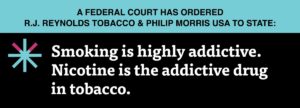
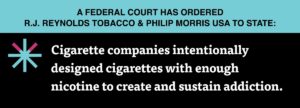

While nicotine itself does not cause cancer, it’s the drug that keeps us consuming products like cigarettes that contain cancer-causing ingredients including arsenic, formaldehyde, benzene, and lead. It is the devastating long-term effects of these chemicals on our health that we are trying to minimize when we quit smoking.
Nicotine Changes Your Brain
Cigarette addiction is not your fault. The nature of addiction involves the relentless pursuit of a drug or behavior that produces a positive reward despite negative consequences. When you take a drag of a cigarette and inhale the smoke, nicotine travels to your lungs and moves quickly to your brain, often within seconds of when it’s inhaled.
Once it hits your brain, nicotine activates several different neurotransmitters, including those responsible for reducing tension and anxiety, appetite suppression, and others whose effects are often perceived as positive. It also triggers the release of endorphins and dopamine, the so-called “feel-good” hormones—nature’s reward system.
Unfortunately, as dopamine levels begin to decline again, we feel the “need” for another cigarette, and the cycle starts again. To make matters worse, as our tolerance for nicotine builds up over time, we need more and more to bring us the level of pleasure we seek. The chemical effects of nicotine in our brains are what keeps us going back for more, which is why it’s so hard to quit.
Add to that the comfort some smokers take in the ritual of smoking, the place it can hold in a daily routine, the camaraderie found with fellow smokers, and there are many reasons why it can be difficult to stop. Research suggests that nicotine is as addictive as heroin, cocaine, or alcohol.
What Tools Can Help Me Quit?
The American Lung Association (ALA) says that it takes a smoker six to eleven attempts before they are completely smoke-free, so if at first you don’t succeed, don’t be discouraged. Whether you decide to go “cold turkey” or take a more measured approach, there are many different tools you can use to help including:
- self-help resources
- counseling
- nicotine replacement therapies (NRT)
- nicotine gum
- nicotine inhaler
- nicotine lozenge
- nicotine nasal spray
- nicotine patch
- prescriptions medications
- varenicline (Chantix®)
- bupropion SR (Zyban®)
- a combination of counseling and medication
Research by the National Institute for Health (NIH) suggests that a combination of counseling and medication is the most effective approach for quitting smoking, nearly tripling your chance of success. By contrast, the ALA says that only 4 to 7 percent of people who try to quit “cold turkey are successful in staying tobacco-free.” While it might seem counterintuitive, nicotine replacement therapy, or NRT, has been found to be helpful by gradually reducing the level of nicotine in your system thereby reducing your cravings for cigarettes and, by extension, the toxic chemicals found in cigarettes. Additionally, the prescription medications listed above have been approved by the FDA. They are considered safe and effective at helping people quit smoking by helping relieve some of the withdrawal symptoms. We encourage you to reach out to your doctor to see what treatments might be best suited to your needs.
Online resources such as the ALA’s Freedom From Smoking Program or the American Cancer Society’s Empowered to Quit can be good places to start looking for information. Phone apps such as the National Cancer Institute’s SmokefreeTXT or the quitSTART app from smokefree.gov can also be helpful. Always remember that it’s a journey. A slip-up doesn’t mean failure but an opportunity to try again. Every day without tobacco is considered a win!
We wish you good luck on your journey away from tobacco.
Contact a Tobacco Litigation Attorney Today
If you or a loved one has developed lung cancer as a result of smoking in Massachusetts and can document your smoking history, we’d be happy to talk to you, free of charge, about the possibility of seeking financial compensation from Big Tobacco. We have secured life-changing verdicts or settlements for hundreds of individuals and their families, including those impacted by tobacco-related diseases.
Additional Resources:
- American Cancer Society
- American Heart Association
- American Lung Association
- CDC – Tips from Former Smokers
- National Cancer Institute (NCI)
- Smokefree.gov
- World Health Organization (WHO) Tobacco Free Initiative
- 1-800-QUIT-NOW (1-800-784-8669)
Big Tobacco’s Dirty Tricks: How Aggressive Advertising Hooked Millions of Smokers
Millions of people who struggle with cigarette addiction wonder how they became so dependent on smoking or why they ever started in the first place. The answer is not as simple as personal choice—it’s the result of a decades-long, highly calculated campaign by the tobacco industry to manipulate consumers into becoming lifelong smokers.
Tobacco companies were fully aware of the devastating health risks posed by nicotine and other harmful chemicals in cigarettes. Still, they deliberately used a range of creative marketing strategies to keep luring new customers while obfuscating the truth about the dangers of smoking. For those already addicted, it was too late.
An executive at tobacco Brown and Williamson, makers of such brands as Carlton, Lucky Strike, and Kool, said it best: “Nicotine is addictive. We are, then, in the business of selling nicotine, an addictive drug.” Even after the link between smoking and lung cancer was established, tobacco companies pushed ahead with their aggressive marketing campaigns. According to an article published in The Tobacco Journal in 1955, “There is no obstacle to large-scale sales of tobacco products that cannot be surmounted by aggressive selling.”
Big Tobacco has poured millions of dollars into advertising and promotion—the five largest cigarette manufacturers spent $8.01 billion in 2022 alone—and in-depth psycho-social research studies to determine the best way to entice people to smoke. The Stanford Research into the Impact of Tobacco Advertising (SRITA) collection currently contains 62,553 tobacco advertisements.
And it worked. Here are just some of the claims made by Big Tobacco over the years that got people hooked:
“Smoking is Healthy!”
In the earliest days of tobacco advertising companies claimed outright that smoking had health benefits, even suggesting that it could help alleviate ailments such as “asthma, bronchitis, hay fever, influenza, and shortness of breath.” A 1931 Chesterfield ad went so far as to state that its cigarettes were “just as pure as the water you drink,” claiming scientific proof of their healthfulness.



As ridiculous as these early claims seem now, touting these supposed health benefits got people to try a product that many subsequently became addicted to.
As public awareness of smoking’s harm spread, tobacco companies began promoting products as “less harmful,” marketing cigarettes with low tar, low nicotine, and filters that supposedly reduced health risks. One of the most insidious tactics was medical endorsements with doctors depicted as enthusiastic smokers in ads, such as the famous “More Doctors Smoke Camels” campaign. This portrayal of medical professionals continued well into the 1990s, when white-coated models appeared in Kool cigarette ads, reinforcing the false narrative of smoking’s safety.




When the 1964 Surgeon General’s Report came out on the dangers of smoking, executives at Big Tobacco knew they had to fight back. Internal communications at the highest levels at Philip Morris International stated: “We must in the near future give smokers a psychological crutch and a self-rationale to continue smoking.”
“Smoking is Cool!”
Tobacco companies have long used their ads to make smoking seem like a symbol of coolness and rebellion, linking smoking to traits like independence, confidence, and freedom. Iconic campaigns featured rugged cowboys, adventurous explorers, or smooth, charismatic figures portraying smoking as part of a carefree, bold lifestyle.
Who can forget the Marlboro Man, named the top advertising icon of the century by Advertising Age in the 1990s, highlighting the character’s pivotal role in making smoking seem cool and desirable? Other brands promoted their products with mascots and cartoon characters like Joe Camel, an easygoing, “smooth character” who embodied a cool vibe that resonated with teens and young people.




Around the same time, tobacco companies introduced vibrant “positive lifestyle” images and imagery of smoking in high-status settings to make smoking seem not only cool but also socially acceptable and even part of a healthy lifestyle. This carefully crafted image played a major role in normalizing smoking and influencing generations to see it as an essential part of a “cool” identity.




“Smoking is Glamorous!”
Smoking has long been associated with glamour due to strategic endorsements by prominent movie and TV stars, athletes, and even politicians. Tobacco companies were great at leveraging the cross-promotional power of Hollywood, using its stars and classic films to elevate the image of smoking.
Movie icons like Audrey Hepburn’s Holly Golightly and Sean Connery’s James Bond were often depicted as effortlessly glamorous while smoking, their chic and sophisticated on-screen personas reinforcing the allure of cigarettes. Publicity images that included cigarette brands and ads featuring celebrity endorsements created an irresistible association between smoking and the glamorous lifestyles of the rich and famous. This carefully cultivated image made cigarettes seem key to achieving style and status.




“Smoking is Empowering!”
Some ads made smoking seem like a form of empowerment for women, tying it to ideas of independence, equality, and strength. Ads portrayed women who smoked as confident, bold, and unafraid to break away from traditional gender roles, showing them in powerful or glamorous roles—like successful professionals or daring adventurers. Big Tobacco positioned smoking as a way to express strength and sophistication, making it seem like lighting up was a way for women to claim their independence and embrace a changing world.




“Smoking is Tasty!”
Tobacco companies have long claimed that their cigarettes taste better than others, often touting their unique blends of tobacco, promising a smoother, richer taste or a “milder” smoke. Some even went so far as to claim their cigarettes were specially crafted to offer a cleaner, more refined flavor. These marketing tactics played on the idea that smoking was not just an addiction but an enjoyable, sensory experience.



Menthol cigarettes were positioned as a smoother, cooler alternative to regular cigarettes. The minty flavor makes the cigarettes “easier” to use, and because of this, the industry acknowledged them as great “starter products.” The sad truth is that menthol enhances nicotine’s addictiveness.
Menthol numbs the cough reflex, which allowed even people who were sensitive to regular cigarettes to take up smoking, another example of how Big Tobacco actively sought to “recruit” more smokers. Marketing of menthol cigarettes was heavily targeted towards African Americans since studies showed that 85% of these smokers preferred menthol cigarettes.




No, It’s Not Your Fault You’re Addicted
The long history of manipulation and deceit in tobacco advertising has left millions of people with lifelong nicotine addictions and, tragically, serious health conditions like lung cancer. Big Tobacco’s deliberate efforts to start and keep people smoking—including young people, teens, and even children—despite knowing the deadly consequences, has resulted in a public health crisis that continues to affect millions today.
Contact a Tobacco Litigation Lawyer Today
If you or a loved one has developed lung cancer as a result of a smoking addiction, you may be entitled to financial compensation. Read more about some of the most frequently asked questions about tobacco litigation in Massachusetts and whether it’s possible to get financial compensation for your lung cancer caused by smoking. If you’d like to know whether you might have a legitimate claim, reach out to our tobacco lawyers at Shepard O’Donnell for a free case evaluation. Please note that at this time, we are only taking cases in which the majority of the patient’s smoking history took place in Massachusetts.
Shepard O’Donnell does not own copyright in these images, and does not offer or license them for public or private use. As to copyright issues for tobacco advertisements, they have been reproduced with regularity in books, scholarly journals, popular magazines, and in numerous online venues for many years for purposes of comment, criticism, or parody, which may be considered transformative and thus considered fair use.
Are You an Auto Mechanic and a Current or Former Smoker? Know Your Risks.
Auto Mechanics and Asbestos Exposure
The risk to auto mechanics of exposure to asbestos has been well documented. Vehicle components such as brake linings, clutch facings, and gaskets in models older than 1990 almost certainly contain asbestos, and manufacturers were still selling asbestos brakes as late as the 2000s. Routine maintenance on these vehicles, involving brake and clutch inspection, cleaning, and repair often releases asbestos fibers into the air, especially when compressed air or dry brushes and rags are used to clean off the dust that has accumulated during years of use. Such cleaning methods blow the asbestos-containing dust up into the surrounding environment, where it is breathed in by anyone standing or working close by. So if you worked in an automotive garage or repair facility but weren’t working directly with brakes, clutches or gaskets, you may still have been exposed to asbestos dust from them.
Asbestos fibers can hang in the air for days, weeks, and sometimes months, and even those who don’t work directly with the contaminated products are at risk of breathing in the airborne fibers, which can then become embedded in the tissue of the lungs. This is especially true in the harsh New England climate where doors and windows are rarely left open in the winter to allow for air circulation.
Although the use of asbestos in automotive friction and gasket products has decreased, these products are a substantial source of potential exposure even today. As a result, auto mechanics, automotive technicians, and at-home DIY mechanics and tinkerers, who work on brakes and clutches are considered to be at increased risk for developing lung cancer and mesothelioma due to asbestos. We urge anyone working around these types of friction products to remain vigilant about their lung health.
Smoking + Asbestos Exposure Increases Your Risk of Lung Cancer
We all know that smoking is the greatest risk factor for lung cancer. But, according to the National Cancer Institute, the combination of smoking and asbestos exposure exponentially increases your risk of developing lung cancer. The synergistic effect of smoking plus asbestos exposure puts auto mechanics who also smoke(d) at a much higher risk for developing lung cancer than the individual risk factors added together. If you’ve been diagnosed with lung cancer, whether due to smoking, asbestos exposure, or both, we urge you to stop smoking right away. If you need help to quit, the American Lung Association has many available resources.
I’m an Auto Mechanic, How Can I Protect Myself?
When you remove a brake disk, drum, clutch cover, or wheel from a vehicle you can see the dust that has collected, but it’s virtually impossible to tell just by looking if that dust contains asbestos. If you’re working on a newer vehicle OSHA recommends that you consult the manufacturer, the parts retailers, and packaging information, to determine whether or not your brake or clutch components contain asbestos. However, that information might not be readily available for older vehicles. As a best practice, OSHA recommends that mechanics should assume that all brakes have asbestos-type shoes. Although home mechanics are not required to follow OSHA regulations, if you are a DIY-er, we encourage you to take your brake and clutch jobs to a professional.
Can I Get Financial Compensation for My Lung Cancer?
Many people, especially those who are or were smokers, don’t consider that the onset of their lung cancer could have been caused or exacerbated by asbestos exposure. If you worked with automotive friction or gasket products at any point in your job history, we encourage you to call us to help you determine if your lung cancer was caused by exposure to asbestos. You might be entitled to financial compensation.
Manufacturers of asbestos-containing products that knowingly exposed workers to this harmful material should be held accountable, as should tobacco companies. We have helped hundreds of individuals and families obtain justice for their injuries, regularly obtaining settlements and verdicts in the millions.
Shepard O’Donnell is currently accepting cases for people living with lung cancer due to smoking and asbestos exposure that took place mainly in Massachusetts.

5 Common Myths About Asbestos and Your Health
Lung cancer is the second most common cancer in both men and women in the United States and happens when cells in the lung mutate or change. Most often, this change occurs as a result of people breathing dangerous, toxic substances, including asbestos. Many people don’t consider that their lung cancer could be due to asbestos exposure and might be a rare form of cancer called mesothelioma. Even 30 years after peak asbestos use in the United States, around 3,000 people are diagnosed with mesothelioma every year.
Since the only confirmed cause of mesothelioma in the U.S. is exposure to asbestos, we urge you to think about possible past exposure, even if you believe you have never been in contact with asbestos.
Learn more about the symptoms and diagnosis of mesothelioma and speak to your doctor if there is even a small chance your lung cancer might be due to asbestos. If your disease is, in fact, mesothelioma, you could have a viable legal claim: mesothelioma patients are still benefiting from life-changing verdicts and settlements in mesothelioma lawsuits in Massachusetts today.
Myth # 1: I Was Never Exposed To Asbestos, So I Can’t Have Mesothelioma
The fact is, no one can categorically say they have never been exposed to asbestos. Surprisingly, asbestos is still not federally banned in the United States even after the link between asbestos fibers and life-threatening respiratory ailments, including mesothelioma, lung cancer, and asbestosis became broadly known. By the 1970s, the hazardous effects of asbestos exposure were well documented and yet some companies continued to use asbestos-containing products and failed to protect their workers from exposure.
More than 3,000 known products contained asbestos, most of which didn’t explicitly state that they contained asbestos. From household items to furnishings to cosmetics, asbestos often lies hidden where you’d least expect it. But asbestos is most commonly found in a wide range of building materials, friction products, heat-resistant fabrics, valve packing, gaskets, and coatings, and people who regularly worked with these and other manufactured products, especially prior to the 1970s, are at elevated risk of having been exposed to asbestos. Read more about common jobs associated with asbestos exposure and why veterans, especially navy veterans, are at higher risk. With so many companies continuing the use of asbestos even after it was deemed unsafe, we urge you to remain vigilant about your lung health. If you suspect you may have been exposed to asbestos in the past, please inform your doctor immediately so they can monitor for symptoms.
Myth #2: I Worked Around Asbestos Years Ago, But It Didn’t Affect Me
Unlike a case of poison ivy, where you break out in a tell-tale rash as soon as you’ve been exposed, asbestos exposure does not produce an immediate reaction. Mesothelioma has a long latency period and typically takes 20-50 years from initial exposure to develop. Sadly, it is often just as workers are set to enjoy their retirement years that they are diagnosed. Since many of the symptoms are similar to other less dangerous illnesses, such as pneumonia, flu, or intestinal issues, it often goes undiagnosed until it has reached the later stages of the disease.
If you or someone you know has experienced any of the symptoms of mesothelioma, we encourage you to seek medical attention right away. It is critical to let your doctor know as early as possible that you may have been exposed to asbestos during your working years. Even if you aren’t currently experiencing any symptoms, ask your doctor to set up regular monitoring.
Myth #3: Only People Directly Exposed to Asbestos Are At Risk
While those exposed directly to airborne asbestos fibers are at the highest risk for developing mesothelioma, family members can also be at risk via secondary exposure to fibers brought home on the clothing of the primary individual. We have seen instances of mesothelioma in wives who routinely did their husband’s asbestos-covered laundry, or in children who hugged dad every day as he came home from work in clothes embedded with asbestos fibers. Asbestos fibers can also linger in the home for years and, once disturbed, pose a dangerous health hazard. While this is indeed rare, it is possible. If you or a family member have been diagnosed with mesothelioma, regardless of whether through direct or secondary exposure to asbestos, you may have a legal claim.
Myth #4: I Have Lung Cancer But It’s Probably Because I Smoke(d)
As a smoker, you may believe that your lung cancer is the result of your smoking history. If, however, you suspect that you may have been exposed to asbestos at some point in your life, you need to consider the possibility that asbestos played a part in causing your cancer. According to the American Cancer Society, lung cancer risk is much greater in workers exposed to asbestos who also smoke.
Lung cancer or Mesothelioma can be difficult to diagnose because it often presents with symptoms that are similar to benign illnesses such as pneumonia, flu, or intestinal issues. Your doctor will likely use a variety of diagnostic tools, including a physical exam, blood and tissue tests, x-rays and other imaging scans, and biopsies to determine whether or not cancer is present, and if so what kind of tumor. If cancer is diagnosed, these tests also help determine how far it has progressed and whether it has spread to other parts of the body. If you have been diagnosed with lung cancer or mesothelioma you may be entitled to financial compensation from asbestos manufacturers, even if you smoke(d).
Myth #5: Asbestos is Banned Now So I Don’t Have To Worry About Getting Sick
Asbestos is not federally banned in the United States, despite incontrovertible evidence that airborne asbestos fibers cause lung disease, lung cancers, and mesothelioma. While no longer as prevalent as it once was, examples of asbestos-containing products continue to come to light even today, including talc commonly used in cosmetics and other personal care products. In 2015, Disney- and Nickelodeon-branded crayons were found to contain traces of asbestos, as were eye shadows and powders sold by Claire’s and Justice stores as recently as 2020.
Many homes, schools and other buildings built before the 1970s have materials such as pipe covering, insulation, popcorn ceilings, and floor tiles that contain asbestos. But just because you live or work in a building built before the 1970s doesn’t necessarily mean you’re at risk. If the asbestos is contained, you are at a relatively low risk of inhaling airborne fibers. If, however, older materials containing asbestos are damaged or disturbed, for example during renovations or demolition, asbestos fibers can be released into the air and pose a dangerous health risk.
If you suspect that there might be asbestos in your home, we encourage you to have a professional evaluate your risk of exposure. Always have asbestos products inspected and repaired or removed by trained and accredited asbestos professionals.
Don’t Miss Out On The Financial Compensation You Deserve
If you think you might have a mesothelioma legal case in Massachusetts, we invite you to reach out to Shepard O’Donnell. We take the time to explain the process from beginning to end, setting realistic expectations and timelines. If you are unable to come to our offices due to health or other reasons, we will come to you to listen to your story and tell you honestly if we think you have a viable claim. We have helped hundreds of individuals and families obtain justice for their injuries, regularly obtaining settlements and verdicts in the millions. And you will never pay unless we deliver results for you.
Frequently Asked Questions About Tobacco Litigation in Massachusetts: Part II
Following up on part one of our frequently asked questions about tobacco litigation in Massachusetts, below are seven additional questions we are commonly asked.
Q: Is it My Own Fault For Not Quitting?
A: No.
As one executive at tobacco company Brown and Williamson, makers of such brands as Carlton, Lucky Strike and Kool, wrote in 1963: “Nicotine is addictive. We are, then, in the business of selling nicotine, an addictive drug.”
In fact, tobacco companies conducted their own research on just how much nicotine was required to get people addicted without making the cigarettes taste bad. Over the years, they have adjusted the amount of nicotine to have the best chance of initiating and sustaining addiction in smokers.
Even if you know smoking is bad for you, it can be challenging to stop. Addiction is not a choice. Some people are biologically more susceptible to nicotine addiction than others. While some might be able to stop or cut back, others might experience unbearable withdrawal symptoms, making it impossible to quit.
And how do the companies respond? As one tobacco company insider put it: “isn’t it fortunate for us that cigarettes are a habit they can’t break.”
Q: How Long Do Tobacco Lawsuits Take?
A: They can take years.
As we know, cigarettes are a billion-dollar industry and tobacco companies have a lot at stake. With very deep pockets, Big Tobacco vigorously defends every case brought against it. But, even though it might have taken years, many individuals and their families have successfully sued tobacco companies for their injuries or death.
Q: What Can I Expect When I File a Tobacco Lawsuit?
A: A comprehensive look at your smoking history.
Because tobacco companies will invariably take your claim to court, you can expect to provide a comprehensive account of your smoking history, including medical records, accounts from friends and family about your smoking habits (including how and when you first started smoking), photos and/or social media posts that show you’ve been a long-time smoker and more. You will also be expected to answer questions from the tobacco company about your smoking history. While all of this may sound daunting, the tobacco lawsuit team at Shepard O’Donnell helps clients pull together all relevant information in preparation for a successful suit.
Q: How Much Can I Expect to Win?
A: $0 or $Millions.
This is a difficult question since every case and fact pattern is different. There are no hard and fast guidelines that allow us (or anybody else) to predict what a jury will decide. There is a very real chance that the award will be negligible. That said, however, the tobacco lawyers at Shepard O’Donnell were recently part of the trial team that won a ground-breaking $43.1 million verdict against RJ Reynolds on behalf of an individual victim. We do not guarantee similar results in future cases, and clients should be aware that even after a lengthy trial, the reward might be zero.
Q: I have COPD or Esophageal Cancer or Heart Disease; Will You Take my Case?
A: Not at this time.
Shepard O’Donnell is currently only taking cases involving lung cancer due to smoking but we are happy to refer you to experienced counsel who can evaluate your case.
Q: What is the Statute of Limitations to File a Tobacco Lawsuit in Massachusetts?
A: Three years (or longer.)
The general statute of limitations for Massachusetts, including for tobacco-related lawsuits, is up to three (3) years from the date your injuries were discovered or from your family member’s death. Even if you think you missed Massachusetts’ statute of limitations, it is still worth speaking with a tobacco lawsuit attorney. We can review the facts of your case to establish which deadline applies to your case and if you still have time or fall under certain statutory exceptions. You can rely on Shepard O’Donnell to consider every legal opportunity.
Q: How Do I Know If I Have a Case?
A: Call the experienced tobacco lawyers at Shepard O’Donnell.
A Massachusetts tobacco lawyer will help you determine which laws apply to your case and how. Shepard O’Donnell will also fully investigate your injuries and help you preserve all admissible, related evidence. Allow an experienced and compassionate tobacco lawsuit attorney on our legal team to evaluate your situation to provide clarity and direction regarding your options. Cigarette and tobacco companies willfully choose to place profits over people. Shepard O’Donnell will stand by your side throughout the entire process while holding these companies accountable for their careless and reckless actions.
Shepard O’Donnell is currently accepting cases for people living with lung cancer due to smoking that took place mainly in Massachusetts.
We have a strong track record of success when representing personal injury and wrongful death victims in matters against tobacco and cigarette companies, including a ground-breaking $43.1 million verdict against RJ Reynolds on behalf of an individual victim.
Frequently Asked Questions About Tobacco Litigation in Massachusetts: Part I
The tobacco industry has knowingly put millions of lives at risk for decades by continuing to actively market cigarettes and smoking, despite being aware of the harmful health effects of inhaling nicotine and other additives into the lungs.
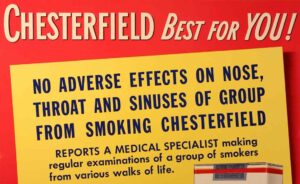
The tobacco lawsuit team at Shepard O’Donnell helps clients with lung cancer due to smoking in Massachusetts obtain justice from tobacco companies for their injuries. We feel strongly about making tobacco companies pay for the grievous harm they have inflicted on individuals and families and are committed to holding them accountable for their actions. Read more about our landmark $43.1 million verdict.
Below are some common questions we are asked about tobacco litigation.
Q: Can I Still File a Tobacco Lawsuit in Massachusetts?
A: Yes.
As it becomes more difficult to file tobacco suits in other states, Massachusetts remains a viable place to bring your tobacco lawsuit. If you or your loved one developed lung cancer or died as a result of smoking in Massachusetts, you may be successful in suing the tobacco company that caused your injuries. Although these cases can be long and complicated, favorable verdicts do happen, even today.
Q: I Live Outside of Massachusetts; Can I File a Tobacco Case?
A: Maybe.
As Massachusetts tobacco lawyers, Shepard O’Donnell is only accepting cases in which the majority of a victim’s smoking history took place in Massachusetts. If you live in another state but started smoking in Massachusetts and spent a significant amount of time here, please reach out to us for a free case evaluation to see if we can help.
Q: Is This a Class Action?
A: No.
The courts have made it more difficult in recent years to file class action suits against Big Tobacco because the class is so big, involving victims nationwide. As a result, tobacco lawsuits are filed on behalf of an individual and/or their family, and each is considered as a separate claim.
Q: Haven’t All Tobacco Cases Been Settled By Now?
A: No.
Big Tobacco vigorously defends its own interests and does not typically settle lawsuits brought against it. With millions of victims still suffering and dying from lung cancer due to smoking, there are potentially many more suits to be filed. Although the Attorneys General from 52 states and territories signed the Tobacco Master Settlement Agreement in 1998, that agreement does not mean that all cases are settled.
Q: My Loved One Died From Lung Cancer Due to Smoking; Can I File a Suit on His/Her Behalf?
A: Yes.
Depending on the specific details of the claim, surviving family members may be able to file a lawsuit on behalf of their loved one. It’s best to contact experienced tobacco lawyers to discuss your case so they can advise you on the best course of action. Shepard O’Donnell offers free case evaluations for individuals and families who have been affected by lung cancer due to smoking in Massachusetts.
Q: Don’t Companies Have a Legitimate Defense Because of the Warnings on Packaging?
A: No.
The relatively strong warnings that we see on cigarette packaging today weren’t mandated by the government until 1998, but by then, millions were already addicted. Before that, warnings were vague and ineffectual: The Federal Cigarette Labeling and Advertising Act of 1965 required that the warning “Caution: Cigarette Smoking May Be Hazardous to Your Health” be placed in small print on one of the side panels of each cigarette package. This was not enough to deter people from smoking, or to adequately warn about the health risks known to the tobacco companies but hidden from the public.
Even with these warnings, tobacco companies continued their aggressive – and deceptive – marketing tactics, effectively contradicting their warnings.
Q: Is it My Own Fault For Starting to Smoke in the First Place?
A: No.
Tobacco companies knew exactly what they were doing when they got millions of people hooked on nicotine. They intentionally marketed to young people and teens, using sexy and fun imagery to convey the idea that smoking was exciting and cool. Think of the Marlboro Man and the cartoon Joe Camel in cigarette ads, or even Sean Connery’s James Bond or Audrey Hepburn on the big screen, looking glamorous through clouds of smoke.
A much more insidious tactic involved handing out free sample packs of cigarettes to children as young as eight years old. Their plan—-a successful one as it turns out—-was to turn these children into addicts and lifelong tobacco consumers.
In a 1953 confidential report for Philip Morris, the researcher writes: “Studies of clinical data tend to confirm the relationship between heavy and prolonged tobacco smoking and incidence of lung cancer.” Did that stop companies from marketing to an impressionable audience? No.
Executives at Big Tobacco knew they had to keep smokers hooked and actively fought back against information that showed smoking was bad for your health. In 1964, after reading the Surgeon General’s Report on the dangers of smoking, internal communications at the highest levels at Philip Morris International revealed a chilling plan: “We must in the near future give smokers a psychological crutch and a self-rationale to continue smoking.”
According to the industry watchdog, Expose Tobacco, the industry “ran deceptive campaigns, misled policymakers even when under oath, and paid for biased research to help create confusion. The longer the truth was withheld, the more people smoked, unaware of the damage it was causing to their bodies.”
Millions of people have fallen victim to the deceptive marketing practices of tobacco companies and have paid a deadly price.
Q: I Smoked Menthol Cigarettes, Is That Different?
A: No.
Menthol cigarettes were invented and designed by the tobacco industry because research showed they were easier to smoke. Menthol numbs the cough reflex, which allowed even people who were sensitive to regular cigarettes to take up smoking. This is yet another example of how Big Tobacco actively sought to “recruit” more smokers.
Marketing of menthol cigarettes was heavily targeted towards African American teenagers and children since studies showed that 85% of Black smokers preferred menthol cigarettes. According to a 2022 NPR report, “tobacco industries specifically found influencers in Black communities and gave them free samples, to build markets surreptitiously. The companies also sponsored events like the Kool Jazz Festival, that included an ad of Dizzy Gillespie next to a pack of Kools.”
Menthol enhances nicotine’s addictiveness and the flavor makes the cigarettes “easier” to use and because of this, they were acknowledged by the industry as great “starter products.” Menthol cigarettes weren’t banned in Massachusetts until 2020!
These are just a few of the questions that we are asked on a regular basis by victims of lung cancer due to smoking. Stay tuned for Part II of our blog, which will be released shortly. We will answer seven more commonly asked questions about suing tobacco companies for financial compensation.
What is “Loss of Consortium” and Do I Have a Claim?
When a loved one is diagnosed with mesothelioma or lung cancer, you and your family members may have a lot of questions. How did they get this disease? What treatments are available? Will I need to take time off work to help care for them? Another question that may come up is: Can we get financial compensation for their injuries?
If, after speaking with an experienced mesothelioma attorney, the answer is yes, you might also consider seeking compensation for the suffering you and any dependent family members will potentially have to go through. While the pursuit of financial compensation for mesothelioma and lung cancer victims is certainly the primary injury claim, there is an often overlooked aspect of these lawsuits: the impact on the injured’s family. This is called a loss of consortium claim.
What is Loss of Consortium?
A devastating medical diagnosis impacts not just the individual diagnosed but the whole family. In close marital relationships, the spouse bears the burden of illness alongside their husband or wife, both during the course of the disease and, even more acutely, following the death of their loved one.
Loss of consortium refers to the loss of marital benefits that a spouse enjoys throughout marriage and includes not just financial considerations, but all aspects of the person’s personal life: love, companionship, comfort and care, emotional and moral support, sexual relations, social activities, as well as daily tasks, chores and errands. In Massachusetts, the victim’s minor children or disabled adult children, also have a right to a loss of consortium claim.
In essence, loss of consortium is a claim that seeks compensation for the loss of the richness and fullness of a relationship, whether marital or parent-child and encompasses many things including:
- Loss of Emotional Connection: When a mesothelioma or lung cancer victim can no longer provide the love and emotional support they once did, family members understandably experience sadness and loneliness at the loss of a meaningful emotional connection. Whether it’s the unconditional love of a spouse or the unfailing moral support and guidance of a parent, the emotional toll of that loss is devastating.
- Loss of a Life Partner: Marriage is a partnership. You are partners in child-rearing, caring for your home and garden, cooking, cleaning, laundry, planning medical appointments and much more. When one partner becomes too weak to help, the other must shoulder added responsibilities and duties, which can lead to stress and exhaustion.
- Loss of Parental Support and Guidance: In Massachusetts, loss of consortium includes the loss of a parent. Parents play an important role in shaping their children’s futures and are often instrumental in providing guidance in education, careers or personal and family life. As a key influence in a child’s life, the loss of a parent can have a significant negative impact on that child’s future.
- Loss of Income: If the injured spouse is unable to work, and/or if you need to give up your job to act as a caregiver, this can put a significant strain on a family’s finances, especially as medical bills start piling up.
- Loss of Social Connection: As your spouse gets weaker, he or she may be unable to participate in social events. You may be hesitant to engage in social activities alone, which could lead to social isolation and an increased risk of depression.
What Does a Loss of Consortium Claim Mean for Your Family?
A loss of consortium claim recognizes that it is because of someone else’s negligence (that is, the companies that knowingly put workers in danger from asbestos) that you are now put in a position to cope with your loved one’s illness, shoulder the burden of maintaining a household, and face a life without a spouse or parent. Companies that knowingly exposed their employees to harmful substances such as asbestos should be held accountable for their actions, not only against the victims themselves, but also the family members who suffer alongside them.
Financial compensation for loss of consortium can help families get through the trying times during the course of the illness, particularly if you’ve had to leave your job to care for your spouse. In addition to household and family responsibilities, you might also need to hire extra help around the house or yard, rearrange living spaces to accommodate medical equipment, or order special meal services to support the patient’s treatment and recovery.
A loss of consortium claim entitles you to recover damages for the entire length of time the injury caused the loss.
How Can I File a Loss of Consortium Claim?
Each marriage and family is unique; therefore, each loss of consortium case is unique. The foundation of a strong loss of consortium claim is proof of a strong marriage and family bond in which family members enjoy interconnected and mutually supportive lives. An experienced mesothelioma lawyer can help advise what claims are best to pursue based on your specific circumstances.
If you or a family member have been diagnosed with mesothelioma, regardless of whether through direct or secondary exposure to asbestos, you may have a claim. Unfortunately, in addition to direct jobsite exposure, we have seen instances of mesothelioma in wives who routinely did their husband’s asbestos-covered laundry, or in children who hugged dad every day as he came home from work in clothes embedded with asbestos fibers. Call us today to determine your next steps, and we’ll help you navigate the process. At Shepard O’Donnell, we have helped hundreds of individuals and their families get justice for their injuries, regularly obtaining settlements and verdicts in the millions. We are happy to offer you a free case evaluation and will tell you honestly if we think you have a viable claim, including a claim for loss of consortium.
5 Nutritional Tips to Help Chemotherapy Patients Stay on Track
Written by: Shepard Law Firm Staff
For many individuals who have been diagnosed with lung cancer or mesothelioma, an important consideration for treatment options includes a discussion of the potential side-effects of each treatment.
Those who choose to undergo chemotherapy treatment for lung cancer or mesothelioma often experience side effects including loss of appetite, nausea, trouble swallowing and other side effects that make eating and holding down food difficult or uncomfortable. In some cases, patients who are undergoing chemotherapy have even reported that their sense of taste has changed, and certain foods seem to take on a metallic taste.
Cancer patients undergoing chemotherapy and other treatments are often told to try to eat “even if you’re not hungry” that can be understandably difficult to do. Although eating may not be pleasant, it is important for anyone who is fighting cancer to maintain a balanced diet.
- Keep a food diary: A food diary will be very helpful in maintaining a balanced diet. Keep track of what you eat, and when. Take notes on what foods are the easiest to eat and what foods are no longer appealing to you. Having this information in writing will be also be very helpful to share with your doctor.
- Stock up on healthy foods that require little or no preparation: While undergoing cancer treatment, finding time to prepare meals may be difficult. Having easy to prepare foods such as frozen vegetables, you will be able to maintain a healthy diet even when finding the time to prepare meals may be difficult.
- Try to eat at the same times every day: A side effect of many cancer treatments is a loss of appetite. Waiting until you are hungry to eat may leave you with insufficient nutrients to maintain your energy and strength. By setting a schedule and eating at the same times each day, you will receive proper nutrition even on days when you may not be hungry.
Ask to meet with a Nutritionist: Many leading hospitals have nutritionists on staff to consult with patients undergoing cancer treatments. If the hospital you are treating at does not have a nutritionist on staff, your doctor can likely refer you to one. Reviewing your food diary and discussing your diet with a nutritionist will ensure that you are eating the right foods to maintain your strength and energy during your cancer treatments. - Eat foods that pack the biggest nutritional punch: Learning which foods provide the greatest levels of necessary nutrients can allow you to maintain a balanced diet without eating large amounts of food. Avocados, nuts, and seeds often provide a great deal of protein and other essential vitamins and nutrients in relatively small servings. A nutritionist can provide you further information as to the nutritional value of different foods.
Cancer patients undergoing chemotherapy often have difficultly eating and swallowing solid food. If you find yourself in this position, you may want to use a smoothie machine or blender to create nutritious drinks and smoothies. Try to incorporate a variety of ingredients into your smoothies, including frozen fruits and vegetables. Green leafy vegetables such as kale and spinach provide iron and other essential vitamins and minerals, and make for an excellent smoothie base. Buying fresh and then freezing them will keep your vegetables from spoiling. Add frozen berries or pineapple to add sweetness to the smoothie and get your Vitamin C. For a protein boost, try adding peanut butter, avocado or Greek yogurt to your smoothie. Throw in a banana to add potassium and texture to the smoothie. Mix and match ingredients until you find the combination that tastes the best.
The following links have further information on the topics of nutrition and diet for individuals undergoing cancer treatments:
http://www.webmd.com/cancer/features/eating-treatment
http://www.cancer.gov/publications/patient-education/eatinghints.pdf
http://www.mayoclinic.org/diseases-conditions/cancer/in-depth/cancer/art-20047536
If you or a loved one is an undergoing treatment for lung cancer or mesothelioma and would like to learn more about your rights please call us for free, confidential consultation (617) 451-9191.







